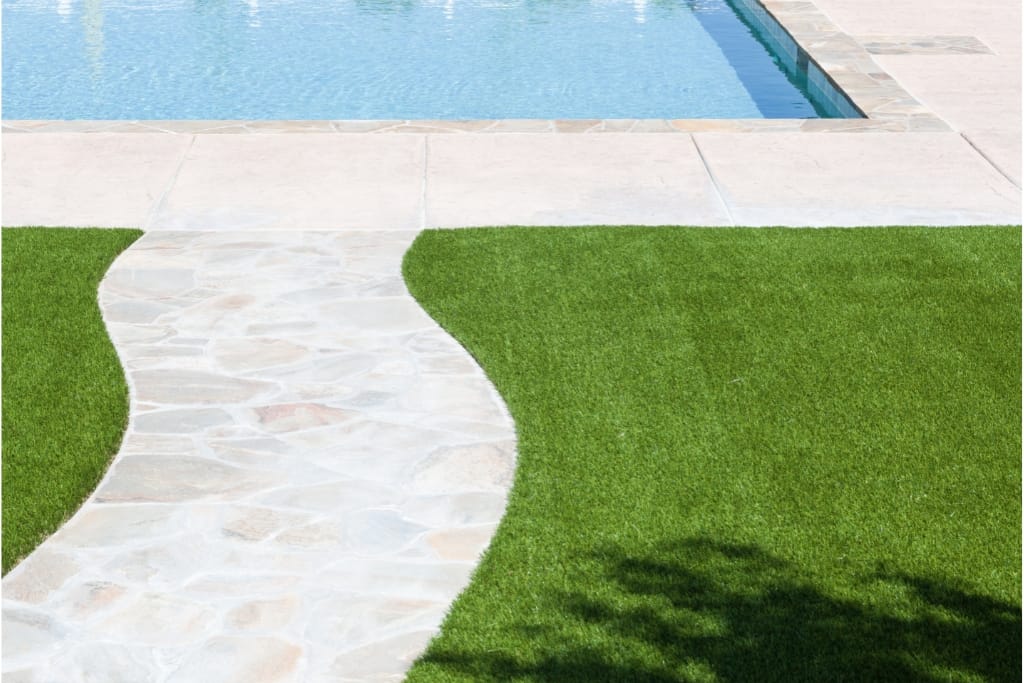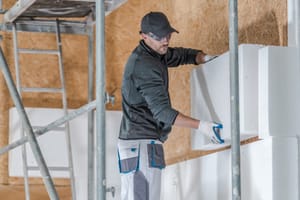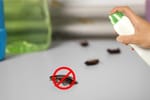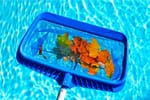Artificial grass can be an aesthetically pleasing, low-maintenance alternative to natural lawns.
It provides a lush, vibrant green look all year round without the watering, mowing, or fertilizing required by natural grass.
However, like any home investment, it demands its unique care to maintain its beauty and longevity.
This article will walk you through the top 10 maintenance tips for your artificial grass, ensuring it remains in the best condition possible for years to come.
So, whether you're a novice or a seasoned artificial turf owner, sit back, and let's dive into these practical and trustworthy tips.
1)) Regular Brushing
It is essential to regularly brush your artificial grass to ensure a natural look and feel.
Brushing will also lift the fibers and prevent the grass from becoming flat or matted.
You can use a stiff bristle broom or rake to do this.
Tips for Effective Brushing of Artificial Grass:
- Use the Right Tools: Ensure that you use a stiff bristle broom or a rake designed for artificial lawns. Such tools will provide the necessary toughness needed to brush and fluff the grass without causing damage.
- Brush in Multiple Directions: To prevent your artificial grass from becoming flat, make sure to brush in different directions. This will ensure an even and natural look.
- Brush Regularly, but Gently: Regular brushing is key to maintaining the appearance of your artificial lawn. However, it's important to strike a balance. Brushing too hard can cause damage. Always brush your artificial grass gently, but frequently.
Regular and gentle brushing with the right tools is the cornerstone of maintaining the aesthetic appeal of your artificial turf.
Not only does it prevent the grass from becoming flat, but it also promotes a natural, fresh look.
So, make brushing an integral part of your artificial grass care regime to enjoy a lush, green lawn year-round.
2)) Remove Debris
Debris such as leaves, twigs, and other organic materials can accumulate on your lawn and create a breeding ground for insects.
Make sure to regularly sweep and remove debris from your artificial turf. It will help to protect your lawn from damage and maintain its appearance.
Tips for Effective Debris Removal from Artificial Grass:
- Use Suitable Equipment: Tools like a leaf blower or a garden vacuum can be highly effective in removing debris. They offer a quick and efficient way to keep your artificial lawn clean.
- Regular Inspection and Cleaning: Regularly inspect your lawn for any debris and clean it as necessary. This will prevent the accumulation of organic matter and stop the development of unwanted pests.
- Consider a Mesh Cover: If your artificial grass is in a location prone to excessive debris, consider using a mesh cover. This can help to reduce the amount of debris that falls onto the lawn, making your cleaning task easier.
Proactive and regular removal of debris from your artificial grass is crucial for its longevity and aesthetics.
By utilizing the right tools, maintaining a routine cleaning schedule, and considering a mesh cover for high-debris areas, you can ensure your artificial lawn remains pristine and inviting.
A clean lawn is not only visually pleasing but also reduces the chances of pest infestations.
Pro-Tip: Investing in an Artificial Turf Vacuum can greatly enhance the maintenance of your artificial grass. These special vacuums are designed to deal effectively with the unique challenges posed by artificial turf, including removing dirt, leaves, and other debris without causing damage to the grass fibers. In addition, they can even help fluff the blades of grass to maintain the natural look and feel of your turf. By using an Artificial Turf Vacuum, you can keep your lawn looking pristine while reducing the time and effort devoted to maintenance tasks. A worthy investment for any artificial grass owner indeed!
3)) Remove Stains
Spills and stains can happen anywhere and the same is true for your artificial lawn.
To remove stains that have set into the fibers, use a mix of water and mild detergent.
Apply the solution to the affected area and blot with a cloth until the stain is completely removed.
Tips for Effective Stain Removal from Artificial Grass:
- Act Quickly: The faster you can address a spill, the less likely it will leave a lasting stain. As soon as a spill occurs, blot any excess liquid and treat the area immediately.
- Use Mild Cleaning Agents: A solution of water and mild detergent is often sufficient for most stains. Avoid using harsh chemicals that could potentially damage the artificial grass fibers.
- Rinse Thoroughly: After applying your cleaning solution and blotting, make sure to rinse the area with water thoroughly. This will ensure no leftover soap residue, which can attract more dirt and debris.
Prompt and effective stain removal is essential in preserving the aesthetic of your artificial grass.
By addressing spills promptly, using mild cleaning agents, and ensuring a thorough rinse, you can maintain the vibrant look of your turf.
A clean and stain-free artificial lawn not only looks appealing but also extends the lifespan of the turf.
4)) Prevent Weeds
Weeds can ruin the appearance of even the most gorgeous lawn.
Although synthetic grass does not provide a good environment for weeds to grow, they can still find their way through the gaps in your lawn.
Use a weed deterrent and regularly check for any weed growth to keep your lawn looking pristine.
Tips for Effective Weed Prevention in Artificial Grass:
- Use a Weed Deterrent: A quality weed deterrent applied to your artificial lawn can help prevent the growth of weeds. Choose one that is safe for use with artificial grass and follow the manufacturer's instructions carefully.
- Regular Inspection: Regularly check for the presence of weeds on your lawn. Early detection can prevent them from spreading and becoming a bigger problem.
- Proper Installation: Ensure that your artificial grass is installed properly with the correct layering of materials. This can serve as a physical barrier, making it harder for weeds to penetrate.
Preventing weed invasion is essential in maintaining the beauty and functionality of your artificial grass.
By utilizing a quality weed deterrent, conducting regular inspections, and ensuring proper installation of your turf, you can effectively thwart weed growth.
A weed-free artificial lawn not only looks attractive but also reduces maintenance burdens.
5)) Prevent Fading
Artificial turf can fade over time due to prolonged exposure to UV rays. To prevent fading, make sure to choose a synthetic grass with built-in UV protection.
You can also use an anti-UV spray to protect your lawn from the sun's harmful rays.
Tips for Effective Prevention of Fading in Artificial Grass:
- Choose UV Resistant Turf: When purchasing artificial grass, ensure that it has built-in UV protection. This will help maintain its vibrant color for a longer period.
- Apply Anti-UV Spray: Regularly applying an anti-UV spray can provide an additional layer of protection against the sun's damaging rays.
- Shade Planning: If possible, plan your landscape in a way that your artificial grass is shaded during peak sun hours. This can significantly reduce the exposure to UV light and prolong the color of your turf.
Proactive measures to prevent the fading of your artificial grass ensure that it retains its vibrant color for a longer period, contributing to an aesthetically pleasing outdoor space.
By opting for UV-resistant turf, applying anti-UV sprays, and smartly planning your landscape to include shading, you can protect your artificial lawn from the damaging effects of prolonged UV exposure.
A well-preserved, fade-resistant lawn not only enhances the appeal of your property but also offers long-term cost-efficiency.
6)) Do Not Use Harsh Chemicals
Avoid using harsh chemicals on your artificial grass as they can cause discoloration and damage. Use only mild detergents and cleaning solutions that are safe for synthetic turf.
Tips for Avoiding Harsh Chemicals on Artificial Grass:
- Opt for Mild Detergents: When cleaning your artificial grass, always choose mild detergents that are safe for synthetic materials. These detergents will be gentle on your grass and will not cause discoloration or damage.
- Natural Alternatives: Consider using natural cleaning alternatives such as vinegar or baking soda. These substances are not only safe for your artificial grass, but they are also environmentally friendly.
- Read Labels Carefully: Always read the labels of cleaning products before using them on your artificial grass. Avoid products that contain harsh chemicals and opt for those that are labeled as safe for use on synthetic materials.
Avoiding the use of harsh chemicals on your artificial grass is critical to preserving its color, texture, and overall health.
By opting for mild detergents, exploring natural cleaning alternatives, and diligently checking product labels, you can ensure that your cleaning process is both efficient and safe for your synthetic turf.
A well-maintained artificial lawn, free from harsh chemical treatments, improves the longevity of the turf, enhancing the beauty of your outdoor space for years to come.
7)) Remove Snow
Artificial turf can withstand snow and ice, but it is essential to remove the snow as soon as possible.
Use a snow blower or snow shovel to clear any snow from your lawn and prevent damage.
Tips for Effective Snow Removal from Artificial Grass:
- Use Appropriate Tools: Utilize a snow blower or a plastic snow shovel for snow removal. Avoid metal shovels or tools with sharp edges as they can damage the artificial turf.
- Clear Regularly: Don't wait for the snow to accumulate. Regularly clean your artificial lawn during heavy snowfall to prevent damage due to excess weight.
- Avoid De-icing Chemicals: While it may be tempting to use de-icing chemicals to melt away the snow, they can damage the synthetic fibers of your turf. Instead, allow the snow to naturally melt and drain away.
Prompt removal of snow from your artificial grass is crucial in maintaining its integrity during the winter months.
Utilizing suitable tools for clearance, regular cleaning during heavy snowfall, and refraining from using de-icing chemicals all contribute to the preservation of your artificial turf.
A well-managed, snow-free artificial lawn not only prevents potential damage but also ensures that your outdoor space remains aesthetically pleasing all year round.
8)) Regular Maintenance
Regular maintenance is key to keeping your artificial grass looking in top condition.
Follow a maintenance schedule that includes brushing, removing debris, and inspecting for any damage or wear.
Tips for Regular Maintenance of Artificial Grass:
- Follow a Routine: Establish a regular maintenance routine that includes brushing the grass fibers, removing debris, and inspecting for any signs of damage or wear. Sticking to this routine can help maintain the pristine condition of your artificial lawn.
- Use a Soft Brush: Use a brush with soft bristles to keep the grass fibers upright and maintain their natural appearance. Avoid using hard brushes as they can cause unnecessary wear and tear.
- Promptly Repair Any Damage: Should you find any damage during your inspection, repair it promptly to prevent it from worsening. Seek professional help for major repairs to ensure the longevity and aesthetics of your artificial turf.
Maintaining your artificial grass regularly is paramount for its longevity and aesthetic appeal.
Adhering to a consistent maintenance routine, using a soft brush for upkeep, and swiftly addressing any damage ensures that your artificial turf remains in top-notch condition.
This not only enhances the visual appeal of your outdoor space but also maximizes your investment in artificial grass by extending its lifespan.
9)) Fix Any Damage
Artificial grass can become damaged due to wear and tear or accidents. If that happens, be sure to repair the damage as soon as possible to prevent further damage.
Small tears or holes can be repaired with a patch while more significant damage may require a complete replacement.
Tips for Repairing Damage on Artificial Grass:
- Identify the Damage: Regularly inspect your artificial grass for any signs of damage. This could include small tears, holes, or significant wear and tear. Early detection can make the repair process simpler and more effective.
- Use Repair Kits for Minor Damages: For minor damages such as small tears or holes, consider using a synthetic grass repair kit. These kits typically include adhesive and artificial grass patches that can cover the affected area.
- Seek Professional Help for Major Damages: If the damage is extensive, it might be best to seek professional help. Severe damages may require a complete turf replacement which should be carried out by professionals to ensure the best results and longevity of your artificial grass.
Addressing damages to your artificial grass promptly and effectively is crucial in maintaining its aesthetic appeal and longevity.
Regular inspections, using repair kits for minor damages, and seeking professional help for major issues are key strategies to tackle any damage.
By being proactive in your repair efforts, you can prevent minor issues from escalating into more significant damage and ensure that your artificial turf remains a beautiful and durable addition to your outdoor space.
10)) Hire Professional Help
If you are unsure about maintaining your artificial grass, it is best to hire professional help.
Professionals have the knowledge, skills, and equipment to keep your synthetic turf looking brand new.
Tips for Hiring Professional Help for Your Artificial Grass:
- Check Credentials: Ensure that the professionals you hire for maintaining your artificial grass have the necessary credentials, experience, and training. This can be confirmed by checking their qualifications, customer reviews, or past project portfolios.
- Compare Services and Prices: Do not settle for the first service you come across. Instead, compare services, pricing, and customer reviews of different professionals to ensure you're getting the best value for your money.
- Ask Questions: Don't hesitate to ask questions about their maintenance process, equipment used, and whether they have experience dealing with the specific type of artificial grass you have installed. This will ensure they are capable of adequately maintaining your turf.
Hiring professional help for the maintenance of your artificial grass can be a sound investment, ensuring the longevity and aesthetic appeal of your turf.
Selecting the right professionals involves checking their credentials, comparing services and pricing, and asking relevant questions about their processes and experience.
By making an informed choice, you can entrust your artificial turf maintenance to skilled hands, freeing up your time and ensuring your lawn remains in pristine condition.
Conclusion
The care and maintenance of artificial grass require a thoughtful and systematic approach for optimal results.
Regular maintenance, prompt repair of any damage, and seeking professional help when necessary are all essential steps for preserving the aesthetics and durability of your artificial turf.
By adhering to these strategies, you can enjoy a lush, green, and hassle-free lawn year-round.
Whether you choose to DIY or hire a professional, the key is consistency and vigilance in maintaining your artificial grass.
Related Articles and Guides:
- How To Clean Artificial Grass
- How To Remove The Smell Of Dog Urine From Artificial Grass
- How To Get Dog Poop Out Of Artificial Grass
- How To Remove Bird Poop From Artificial Grass
- How To Get Paint Off Artificial Grass
- How To Clean Flooded Artificial Grass
- How To Remove Leaves From Artificial Grass
- How To Vacuum Artificial Grass
- 10 FAQs About How To Take Care Of Artificial Grass
Download Our Free E-book!








